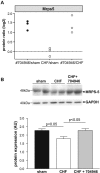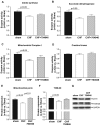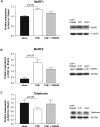Small-molecule-mediated chemical knock-down of MuRF1/MuRF2 and attenuation of diaphragm dysfunction in chronic heart failure
- PMID: 31140761
- PMCID: PMC6818456
- DOI: 10.1002/jcsm.12448
Small-molecule-mediated chemical knock-down of MuRF1/MuRF2 and attenuation of diaphragm dysfunction in chronic heart failure
Abstract
Background: Chronic heart failure (CHF) leads to diaphragm myopathy that significantly impairs quality of life and worsens prognosis. In this study, we aimed to assess the efficacy of a recently discovered small-molecule inhibitor of MuRF1 in treating CHF-induced diaphragm myopathy and loss of contractile function.
Methods: Myocardial infarction was induced in mice by ligation of the left anterior descending coronary artery. Sham-operated animals (sham) served as controls. One week post-left anterior descending coronary artery ligation animals were randomized into two groups-one group was fed control rodent chow, whereas the other group was fed a diet containing 0.1% of the compound ID#704946-a recently described MuRF1-interfering small molecule. Echocardiography confirmed development of CHF after 10 weeks. Functional and molecular analysis of the diaphragm was subsequently performed.
Results: Chronic heart failure induced diaphragm fibre atrophy and contractile dysfunction by ~20%, as well as decreased activity of enzymes involved in mitochondrial energy production (P < 0.05). Treatment with compound ID#704946 in CHF mice had beneficial effects on the diaphragm: contractile function was protected, while mitochondrial enzyme activity and up-regulation of the MuRF1 and MuRF2 was attenuated after infarct.
Conclusions: Our murine CHF model presented with diaphragm fibre atrophy, impaired contractile function, and reduced mitochondrial enzyme activities. Compound ID#704946 rescued from this partially, possibly by targeting MuRF1/MuRF2. However, at this stage of our study, we refrain to claim specific mechanism(s) and targets of compound ID#704946, because the nature of changes after 12 weeks of feeding is likely to be complex and is not necessarily caused by direct mechanistic effects.
Keywords: Cardiac cachexia; Chronic heart failure; Diaphragm; Mitochondrial metabolism; MuRF1; Muscle wasting.
© 2019 The Authors. Journal of Cachexia, Sarcopenia and Muscle published by John Wiley & Sons Ltd on behalf of the Society on Sarcopenia, Cachexia and Wasting Disorders.
Conflict of interest statement
Patent pending for compound ID#704946 and its application to chronic muscle stress states.
Figures








References
-
- Wannamethee GS, Shaper AG, Lennon L, Whincup PH. Decreased muscle mass and increased central adiposity are independently related to mortality in older men. Am J Clin Nutr 2007;86:1339–1346. - PubMed
-
- Rantanen T, Harris T, Leveille SG, Visser M, Foley D, Masaki K, et al. Muscle strength and body mass index as long‐term predictors of mortality in initially healthy men. J Gerontol A Biol Sci Med Sci 2018;55:M168–M173. - PubMed
-
- Martin L, Birdsell L, MacDonald N, Reiman T, Clandinin MT, McCargar LJ, et al. Cancer cachexia in the age of obesity: skeletal muscle depletion is a powerful prognostic factor, independent of body mass index. J Clin Oncol 2013;31:1539–1547. - PubMed
-
- Fülster S, Tacke M, Sandek A, Ebner N, Tschöpe C, Doehner W, et al. Muscle wasting in patients with chronic heart failure: results from the studies investigating co‐morbidities aggravating heart failure (SICA‐HF). Eur Heart J 2013;34:512–519. - PubMed
-
- Lecker SH, Solomon V, Mitch WE, Goldberg AL. Muscle protein breakdown and the critical role of the ubiquitin–proteasome pathway in normal and disease states. J Nutr 1999;129:227S. - PubMed
Publication types
MeSH terms
Substances
Grants and funding
LinkOut - more resources
Full Text Sources
Medical

